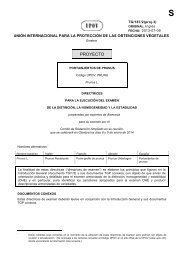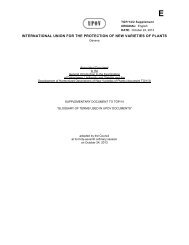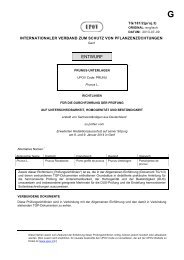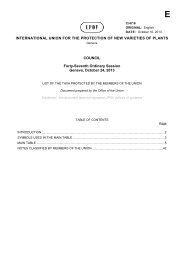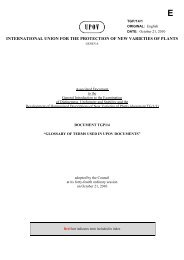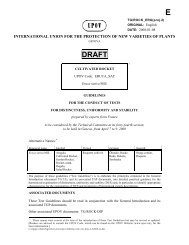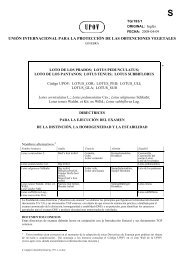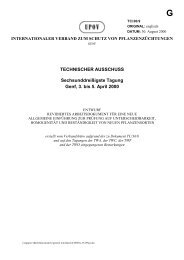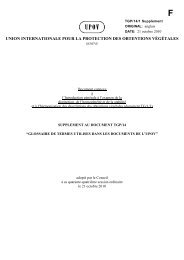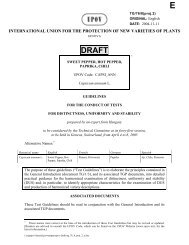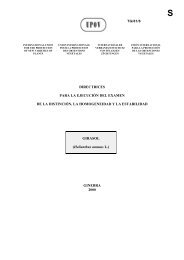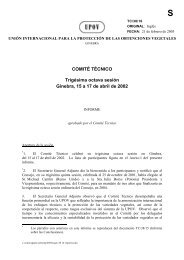draft - International Union for the Protection of New Varieties of Plants
draft - International Union for the Protection of New Varieties of Plants
draft - International Union for the Protection of New Varieties of Plants
Create successful ePaper yourself
Turn your PDF publications into a flip-book with our unique Google optimized e-Paper software.
n:\orgupov\shared\tg\peach_cd\upov_<strong>draft</strong>s\tg_53_6_rev_proj_3xxx.doc<br />
TG/53/6 Rev.(proj.3)<br />
ORIGINAL: English<br />
DATE: 2008-05-26<br />
INTERNATIONAL UNION FOR THE PROTECTION OF NEW VARIETIES OF PLANTS<br />
GENEVA<br />
DRAFT<br />
PEACH<br />
UPOV Code: PRUNU_PER<br />
Prunus persica (L.) Batsch<br />
GUIDELINES<br />
FOR THE CONDUCT OF TESTS<br />
FOR DISTINCTNESS, UNIFORMITY AND STABILITY<br />
prepared by an expert from France<br />
to be considered by <strong>the</strong><br />
Technical Working Party <strong>for</strong> Fruit Crops<br />
at its thirty-ninth session, to be held in Lisbon, Portugal, from June 2 to 6, 2008<br />
Alternative Names: *<br />
Botanical name English French German Spanish<br />
Prunus persica (L.) Batsch,<br />
Persica vulgaris Mill.,<br />
Prunus L. subg. Persica,<br />
Peach Pêcher Pfirsich, Duraznero,<br />
Durazno,<br />
Melocotonero<br />
The purpose <strong>of</strong> <strong>the</strong>se guidelines (“Test Guidelines”) is to elaborate <strong>the</strong> principles contained in<br />
<strong>the</strong> General Introduction (document TG/1/3), and its associated TGP documents, into detailed<br />
practical guidance <strong>for</strong> <strong>the</strong> harmonized examination <strong>of</strong> distinctness, uni<strong>for</strong>mity and stability<br />
(DUS) and, in particular, to identify appropriate characteristics <strong>for</strong> <strong>the</strong> examination <strong>of</strong> DUS<br />
and production <strong>of</strong> harmonized variety descriptions.<br />
ASSOCIATED DOCUMENTS<br />
These Test Guidelines should be read in conjunction with <strong>the</strong> General Introduction, its<br />
associated TGP documents and <strong>the</strong> Test Guidelines <strong>for</strong> Prunus Rootstocks, document<br />
TG/187/1<br />
* These names were correct at <strong>the</strong> time <strong>of</strong> <strong>the</strong> introduction <strong>of</strong> <strong>the</strong>se Test Guidelines but may be revised or updated.<br />
[Readers are advised to consult <strong>the</strong> UPOV Code, which can be found on <strong>the</strong> UPOV Website (www.upov.int), <strong>for</strong> <strong>the</strong><br />
latest in<strong>for</strong>mation.]<br />
*<br />
E
TG/53/6/Rev.(proj.3)<br />
Peach, 2008-05-26<br />
page 2<br />
TABLE OF CONTENTS PAGE<br />
1. SUBJECT OF THESE TEST GUIDELINES..................................................................................................3<br />
2. MATERIAL REQUIRED ...............................................................................................................................3<br />
3. METHOD OF EXAMINATION.....................................................................................................................3<br />
3.1 Number <strong>of</strong> Growing Cycles ....................................................................................................................3<br />
3.2 Testing Place...........................................................................................................................................3<br />
3.3 Conditions <strong>for</strong> Conducting <strong>the</strong> Examination...........................................................................................3<br />
3.4 Test Design .............................................................................................................................................4<br />
3.5 Number <strong>of</strong> <strong>Plants</strong> / Parts <strong>of</strong> <strong>Plants</strong> to be Examined.................................................................................4<br />
3.6 Additional Tests ......................................................................................................................................4<br />
4. ASSESSMENT OF DISTINCTNESS, UNIFORMITY AND STABILITY...................................................4<br />
4.1 Distinctness .............................................................................................................................................4<br />
4.2 Uni<strong>for</strong>mity...............................................................................................................................................5<br />
4.3 Stability ...................................................................................................................................................5<br />
5. GROUPING OF VARIETIES AND ORGANIZATION OF THE GROWING TRIAL.................................5<br />
6. INTRODUCTION TO THE TABLE OF CHARACTERISTICS...................................................................6<br />
6.1 Categories <strong>of</strong> Characteristics...................................................................................................................6<br />
6.2 States <strong>of</strong> Expression and Corresponding Notes.......................................................................................6<br />
6.3 Types <strong>of</strong> Expression................................................................................................................................6<br />
6.4 Example <strong>Varieties</strong> ...................................................................................................................................6<br />
6.5 Legend.....................................................................................................................................................6<br />
7. TABLE OF CHARACTERISTICS/TABLEAU DES<br />
CARACTÈRES/MERKMALSTABELLE/TABLA DE CARACTERES.......................................................7<br />
8. EXPLANATIONS ON THE TABLE OF CHARACTERISTICS ................................................................30<br />
8.1 Explanations covering several characteristics.......................................................................................30<br />
8.2 Explanations <strong>for</strong> individual characteristics ...........................................................................................30<br />
9. LITERATURE ..............................................................................................................................................36<br />
10 TECHNICAL QUESTIONNAIRE ...............................................................................................................38
1. Subject <strong>of</strong> <strong>the</strong>se Test Guidelines<br />
TG/53/6/Rev.(proj.3)<br />
Peach, 2008-05-26<br />
page 3<br />
These Test Guidelines apply to all varieties <strong>of</strong> peach (including nectarine) <strong>of</strong> <strong>the</strong><br />
species Prunus persica (L.) Batsch.<br />
2. Material Required<br />
2.1 The competent authorities decide on <strong>the</strong> quantity and quality <strong>of</strong> <strong>the</strong> plant material<br />
required <strong>for</strong> testing <strong>the</strong> variety and when and where it is to be delivered. Applicants<br />
submitting material from a State o<strong>the</strong>r than that in which <strong>the</strong> testing takes place must ensure<br />
that all customs <strong>for</strong>malities and phytosanitary requirements are complied with.<br />
2.2 The material is to be supplied in <strong>the</strong> <strong>for</strong>m <strong>of</strong> budsticks, dormant shoots <strong>for</strong> grafting,<br />
[France 2008: or standard grafted trees, with dormant buds or not,], grafted on appropriate<br />
peach rootstock to be selected by <strong>the</strong> competent authorities.<br />
Fr 08: France mind you on <strong>the</strong> risk to adopt budsticks furniture (<strong>of</strong>f types buds…)<br />
2.3 The minimum quantity <strong>of</strong> plant material, to be supplied by <strong>the</strong> applicant, should be:<br />
– 5 budsticks with sufficient buds to propagate 5 trees (to be sent at budding time);<br />
– 5 dormant shoots <strong>for</strong> grafting, sufficient to propagate 5 trees (to be sent at<br />
grafting time); [France 2008: this furniture point is not to be understood as it is<br />
written] or<br />
– 5 trees grafted, Fr 08: with dormant buds or not, on appropriate peach rootstock<br />
to be selected by <strong>the</strong> competent authorities<br />
2.4 The plant material supplied should be visibly healthy, not lacking in vigor, nor<br />
affected by any important pest or disease.<br />
2.5 The plant material should not have undergone any treatment which would affect <strong>the</strong><br />
expression <strong>of</strong> <strong>the</strong> characteristics <strong>of</strong> <strong>the</strong> variety, unless <strong>the</strong> competent authorities allow or<br />
request such treatment. If it has been treated, full details <strong>of</strong> <strong>the</strong> treatment must be given.<br />
3. Method <strong>of</strong> Examination<br />
3.1 Number <strong>of</strong> Growing Cycles<br />
The minimum duration <strong>of</strong> tests should normally be two independent growing cycles.<br />
3.2 Testing Place<br />
Tests are normally conducted at one place. In <strong>the</strong> case <strong>of</strong> tests conducted at more than<br />
one place, guidance is provided in TGP/9 “Examining Distinctness”.<br />
3.3 Conditions <strong>for</strong> Conducting <strong>the</strong> Examination<br />
3.3.1 The tests should be carried out under conditions ensuring satisfactory growth <strong>for</strong> <strong>the</strong><br />
expression <strong>of</strong> <strong>the</strong> relevant characteristics <strong>of</strong> <strong>the</strong> variety and <strong>for</strong> <strong>the</strong> conduct <strong>of</strong> <strong>the</strong><br />
examination.
TG/53/6/Rev.(proj.3)<br />
Peach, 2008-05-26<br />
page 4<br />
3.3.2 In particular, it is essential that <strong>the</strong> [trees] / [plants] produce a satisfactory crop <strong>of</strong> fruit<br />
in each <strong>of</strong> <strong>the</strong> two growing cycles.<br />
3.3.3 Because daylight varies, color determinations made against a color chart should be<br />
made ei<strong>the</strong>r in a suitable cabinet providing artificial daylight or in <strong>the</strong> middle <strong>of</strong> <strong>the</strong> day in a<br />
room without direct sunlight. The spectral distribution <strong>of</strong> <strong>the</strong> illuminant <strong>for</strong> artificial daylight<br />
should con<strong>for</strong>m with <strong>the</strong> CIE Standard <strong>of</strong> Preferred Daylight D 6500 and should fall within<br />
<strong>the</strong> tolerances set out in <strong>the</strong> British Standard 950, Part I. These determinations should be<br />
made with <strong>the</strong> plant part placed against a white background.<br />
3.4 Test Design<br />
3.4.1 Each test should be designed to result in a total <strong>of</strong> at least 5 trees, as a minimum.<br />
3.4.2 The design <strong>of</strong> <strong>the</strong> tests should be such that plants or parts <strong>of</strong> plants may be removed<br />
<strong>for</strong> measurement or counting without prejudice to <strong>the</strong> observations which must be made up to<br />
<strong>the</strong> end <strong>of</strong> <strong>the</strong> growing cycle.<br />
3.5 Number <strong>of</strong> <strong>Plants</strong> / Parts <strong>of</strong> <strong>Plants</strong> to be Examined<br />
Unless o<strong>the</strong>rwise indicated, all observations should be made on 5 plants or parts taken<br />
from each <strong>of</strong> 5 plants. In <strong>the</strong> case <strong>of</strong> parts <strong>of</strong> plants, <strong>the</strong> number to be taken from each <strong>of</strong> <strong>the</strong><br />
plants should be 5.<br />
3.6 Additional Tests<br />
Additional tests, <strong>for</strong> examining relevant characteristics, may be established.<br />
4. Assessment <strong>of</strong> Distinctness, Uni<strong>for</strong>mity and Stability<br />
4.1 Distinctness<br />
4.1.1 General Recommendations<br />
It is <strong>of</strong> particular importance <strong>for</strong> users <strong>of</strong> <strong>the</strong>se Test Guidelines to consult <strong>the</strong> General<br />
Introduction prior to making decisions regarding distinctness. However, <strong>the</strong> following points<br />
are provided <strong>for</strong> elaboration or emphasis in <strong>the</strong>se Test Guidelines.<br />
4.1.2 Consistent Differences<br />
The differences observed between varieties may be so clear that more than one<br />
growing cycle is not necessary. In addition, in some circumstances, <strong>the</strong> influence <strong>of</strong> <strong>the</strong><br />
environment is not such that more than a single growing cycle is required to provide<br />
assurance that <strong>the</strong> differences observed between varieties are sufficiently consistent. One<br />
means <strong>of</strong> ensuring that a difference in a characteristic, observed in a growing trial, is<br />
sufficiently consistent is to examine <strong>the</strong> characteristic in at least two independent growing<br />
cycles.
4.1.3 Clear Differences<br />
TG/53/6/Rev.(proj.3)<br />
Peach, 2008-05-26<br />
page 5<br />
Determining whe<strong>the</strong>r a difference between two varieties is clear depends on many<br />
factors, and should consider, in particular, <strong>the</strong> type <strong>of</strong> expression <strong>of</strong> <strong>the</strong> characteristic being<br />
examined, i.e. whe<strong>the</strong>r it is expressed in a qualitative, quantitative, or pseudo-qualitative<br />
manner. There<strong>for</strong>e, it is important that users <strong>of</strong> <strong>the</strong>se Test Guidelines are familiar with <strong>the</strong><br />
recommendations contained in <strong>the</strong> General Introduction prior to making decisions regarding<br />
distinctness.<br />
4.2 Uni<strong>for</strong>mity<br />
4.2.1 It is <strong>of</strong> particular importance <strong>for</strong> users <strong>of</strong> <strong>the</strong>se Test Guidelines to consult <strong>the</strong> General<br />
Introduction prior to making decisions regarding uni<strong>for</strong>mity. However, <strong>the</strong> following points<br />
are provided <strong>for</strong> elaboration or emphasis in <strong>the</strong>se Test Guidelines:<br />
4.2.2 For <strong>the</strong> assessment <strong>of</strong> uni<strong>for</strong>mity, a population standard <strong>of</strong> 1% and an acceptance<br />
probability <strong>of</strong> at least 95% should be applied. In <strong>the</strong> case <strong>of</strong> a sample size <strong>of</strong> 5 plants,<br />
no <strong>of</strong>f-types are allowed.<br />
4.3 Stability<br />
4.3.1 In practice, it is not usual to per<strong>for</strong>m tests <strong>of</strong> stability that produce results as certain as<br />
those <strong>of</strong> <strong>the</strong> testing <strong>of</strong> distinctness and uni<strong>for</strong>mity. However, experience has demonstrated<br />
that, <strong>for</strong> many types <strong>of</strong> variety, when a variety has been shown to be uni<strong>for</strong>m, it can also be<br />
considered to be stable.<br />
4.3.2 Where appropriate, or in cases <strong>of</strong> doubt, stability may be tested, ei<strong>the</strong>r by growing a<br />
fur<strong>the</strong>r generation, or by testing a new plant stock to ensure that it exhibits <strong>the</strong> same<br />
characteristics as those shown by <strong>the</strong> previous material supplied.<br />
5. Grouping <strong>of</strong> <strong>Varieties</strong> and Organization <strong>of</strong> <strong>the</strong> Growing Trial<br />
5.1 The selection <strong>of</strong> varieties <strong>of</strong> common knowledge to be grown in <strong>the</strong> trial with <strong>the</strong><br />
candidate varieties and <strong>the</strong> way in which <strong>the</strong>se varieties are divided into groups to facilitate<br />
<strong>the</strong> assessment <strong>of</strong> distinctness are aided by <strong>the</strong> use <strong>of</strong> grouping characteristics.<br />
5.2 Grouping characteristics are those in which <strong>the</strong> documented states <strong>of</strong> expression, even<br />
where produced at different locations, can be used, ei<strong>the</strong>r individually or in combination with<br />
o<strong>the</strong>r such characteristics: (a) to select varieties <strong>of</strong> common knowledge that can be excluded<br />
from <strong>the</strong> growing trial used <strong>for</strong> examination <strong>of</strong> distinctness; and (b) to organize <strong>the</strong> growing<br />
trial so that similar varieties are grouped toge<strong>the</strong>r.<br />
5.3 The following have been agreed as useful grouping characteristics:<br />
(a) Tree: size (characteristic 1)<br />
(b) Flower: type (characteristic 8)<br />
(c) Petiole: nectaries (characteristic 28)<br />
(d) Fruit: pubescence (characteristic 48)<br />
(e) Fruit: main color <strong>of</strong> flesh (characteristic 55)<br />
(f) Stone: adherence to flesh (characteristic 68)<br />
(g) Time <strong>of</strong> beginning <strong>of</strong> flowering (characteristic 76)<br />
(h) Time <strong>of</strong> maturity <strong>for</strong> consumption (characteristic 78)
TG/53/6/Rev.(proj.3)<br />
Peach, 2008-05-26<br />
page 6<br />
5.4 Guidance <strong>for</strong> <strong>the</strong> use <strong>of</strong> grouping characteristics, in <strong>the</strong> process <strong>of</strong> examining<br />
distinctness, is provided through <strong>the</strong> General Introduction.<br />
6. Introduction to <strong>the</strong> Table <strong>of</strong> Characteristics<br />
6.1 Categories <strong>of</strong> Characteristics<br />
6.1.1 Standard Test Guidelines Characteristics<br />
Standard Test Guidelines characteristics are those which are approved by UPOV <strong>for</strong><br />
examination <strong>of</strong> DUS and from which members <strong>of</strong> <strong>the</strong> <strong>Union</strong> can select those suitable <strong>for</strong> <strong>the</strong>ir<br />
particular circumstances.<br />
6.1.2 Asterisked Characteristics<br />
Asterisked characteristics (denoted by *) are those included in <strong>the</strong> Test Guidelines<br />
which are important <strong>for</strong> <strong>the</strong> international harmonization <strong>of</strong> variety descriptions and should<br />
always be examined <strong>for</strong> DUS and included in <strong>the</strong> variety description by all members <strong>of</strong> <strong>the</strong><br />
<strong>Union</strong>, except when <strong>the</strong> state <strong>of</strong> expression <strong>of</strong> a preceding characteristic or regional<br />
environmental conditions render this inappropriate.<br />
6.2 States <strong>of</strong> Expression and Corresponding Notes<br />
States <strong>of</strong> expression are given <strong>for</strong> each characteristic to define <strong>the</strong> characteristic and to<br />
harmonize descriptions. Each state <strong>of</strong> expression is allocated a corresponding numerical note<br />
<strong>for</strong> ease <strong>of</strong> recording <strong>of</strong> data and <strong>for</strong> <strong>the</strong> production and exchange <strong>of</strong> <strong>the</strong> description.<br />
6.3 Types <strong>of</strong> Expression<br />
An explanation <strong>of</strong> <strong>the</strong> types <strong>of</strong> expression <strong>of</strong> characteristics (qualitative, quantitative<br />
and pseudo-qualitative) is provided in <strong>the</strong> General Introduction.<br />
6.4 Example <strong>Varieties</strong><br />
Where appropriate, example varieties are provided to clarify <strong>the</strong> states <strong>of</strong> expression <strong>of</strong><br />
each characteristic.<br />
6.5 Legend<br />
(*) Asterisked characteristic – see Chapter 6.1.2<br />
QL: Qualitative characteristic – see Chapter 6.3<br />
QN: Quantitative characteristic – see Chapter 6.3<br />
PQ: Pseudo-qualitative characteristic – see Chapter 6.3<br />
(a)-(f) See Explanations on <strong>the</strong> Table <strong>of</strong> Characteristics in Chapter 8.1<br />
(+) See Explanations on <strong>the</strong> Table <strong>of</strong> Characteristics in Chapter 8.2
1.<br />
(*)<br />
TG/53/6/Rev.(proj.3)<br />
Peach, 2008-05-26<br />
page 7<br />
7. Table <strong>of</strong> Characteristics/Tableau des caractères/Merkmalstabelle/Tabla de caracteres<br />
English<br />
Tree: size<br />
(Fr 08: in winter)<br />
français<br />
Arbre: taille<br />
(Fr 08 : en hiver)<br />
deutsch<br />
Baum: Größe<br />
español<br />
Example <strong>Varieties</strong>/<br />
Exemples/<br />
Beispielssorten/<br />
Variedades ejemplos<br />
QN very small très petit sehr klein Bonanza 1<br />
2.<br />
(+)<br />
small petit klein Richaven 3<br />
medium moyen mittel Robin 5<br />
large grand groß Redhaven 7<br />
very large très grand sehr groß Champion 9<br />
Tree: vigor<br />
(Fr 08: during<br />
growing period)<br />
Arbre: vigueur<br />
(Fr 08: en<br />
végétation)<br />
Baum: Wuchsstärke<br />
QN weak faible gering J. H. Hale 3<br />
3.<br />
(*)<br />
(+)<br />
medium moyenne mittel Robin 5<br />
strong <strong>for</strong>te stark Springtime 7<br />
Tree: habit<br />
(Fr 08: in winter)<br />
Arbre: port Baum: Wuchs<strong>for</strong>m<br />
QN upright dressé aufrecht Nectarose, Pillar 1<br />
4.<br />
(+)<br />
upright to spreading Fairhaven, Redwing 2<br />
spreading étalé breitwüchsig Elegant Lady,<br />
O’Henry Albertina<br />
drooping retombant überhängend Cocont Ice,<br />
Scarlet O’Hara<br />
weeping très retombant lang überhängend Biancopendulo 5<br />
Flowering shoot:<br />
thickness<br />
(Fr 08: in winter)<br />
Rameau mixte:<br />
grosseur<br />
Blütentrieb: Dicke<br />
QN thin fin dünn Mayred 3<br />
medium moyen mittel Redhaven 5<br />
thick gros dick Lizzie, Flavorcrest 7<br />
2007 - 4a to check if characteristic “tendency to produce on brindilles”is necessary. France: not necessary, can be added in <strong>the</strong><br />
observations if needed. TWF 2007: Answer to be not introduced – France 08: keep it<br />
Note/<br />
Nota<br />
3<br />
4
English<br />
5. Flowering shoot:<br />
length <strong>of</strong> internodes<br />
(as <strong>for</strong> 4)<br />
français<br />
Rameau mixte:<br />
longueur des<br />
entrenœuds (comme<br />
pour 4)<br />
TG/53/6/Rev.(proj.3)<br />
Peach, 2008-05-26<br />
page 8<br />
deutsch<br />
Blütentrieb: Länge<br />
der Internodien (wie<br />
unter 4)<br />
español<br />
Example <strong>Varieties</strong>/<br />
Exemples/<br />
Beispielssorten/<br />
Variedades ejemplos<br />
QN very short très courts sehr kurz Bonanza 1<br />
6.<br />
(*)<br />
short courts kurz June Gold,<br />
Merrill Sundance<br />
medium moyens mittel Redhaven 5<br />
long longs lang Fairhaven 7<br />
very long très longs sehr lang 9<br />
DELETED in 2007<br />
and combined with<br />
<strong>the</strong> <strong>New</strong> 6 below<br />
Flowering shoot:<br />
anthocyanin<br />
coloration<br />
Rameau mixte: Wahrer<br />
pigmentation Fruchttrieb:<br />
anthocyanique Anthocyanfärbung<br />
(comme pour 4, coté (wie unter 4, nicht<br />
ensoleillé exclu) auf der Sonnenseite)<br />
? absent absente fehlend De flor doble blanca 1<br />
6.<br />
(*)<br />
present présente vorhanden Springtime 9<br />
Flowering shoot:<br />
intensity <strong>of</strong><br />
anthocyanin<br />
coloration (shaded<br />
side)<br />
Rameau mixte:<br />
intensité de la<br />
pigmentation<br />
anthocyanique (sur<br />
la face à l’ombre)<br />
Wahrer<br />
Fruchttrieb: Dichte<br />
der Blütenknospen<br />
(……………..)<br />
(Fr 08: would like to<br />
have absent (1) and<br />
very weak (3)….<br />
? absent or very weak absent ou très faible De flor doble blanca 1<br />
weak faible gering Springtime 3<br />
medium moyenne mittel Fuzalode 5<br />
strong <strong>for</strong>te stark Robin,<br />
Sanguine Chanas<br />
Note/<br />
Nota<br />
3<br />
7
English<br />
français<br />
TG/53/6/Rev.(proj.3)<br />
Peach, 2008-05-26<br />
page 9<br />
deutsch<br />
español<br />
Example <strong>Varieties</strong>/<br />
Exemples/<br />
Beispielssorten/<br />
Variedades ejemplos<br />
Remarks from NZ and Brazil <strong>for</strong> <strong>the</strong> low variability in <strong>the</strong>ir material <strong>for</strong> this characteristic, but not in <strong>the</strong> European one (pascal) Datas<br />
inserted <strong>for</strong> in<strong>for</strong>mation <strong>for</strong> <strong>the</strong> <strong>draft</strong>ers : TWF 2007 T.Pascal arguments accepted<br />
7.<br />
(+)<br />
Flowering shoot:<br />
density <strong>of</strong> flower<br />
buds (as <strong>for</strong> 4)<br />
Rameau mixte:<br />
densité des boutons<br />
floraux (comme<br />
pour 4)<br />
QN very sparse très peu dense < 10<br />
fleurs/m<br />
sparse peu dense 10 a 20<br />
fleurs/m<br />
medium moyenne 20 a 30<br />
fleurs/m<br />
dense dense 30 a 40<br />
fleurs/m<br />
very dense très dense >40<br />
fleurs/m<br />
Wahrer<br />
Fruchttrieb:<br />
vorwiegende<br />
Anordnung der<br />
Blütenknospen (wie<br />
unter 4)<br />
NZ proposes to delete (France can accept <strong>the</strong> deletion) : TWF 2007 : deleted<br />
9. - Flowering shoot:<br />
general distribution<br />
<strong>of</strong> flower buds (as<br />
<strong>for</strong> 4)<br />
Rameau mixte:<br />
répartition générale<br />
des boutons floraux<br />
(comme pour 4)<br />
Note/<br />
Nota<br />
Monline 1<br />
locker Bigtop, O’Henry 3<br />
mittel Mélina, Michelini,<br />
Richlady<br />
dicht Jade, Redhaven 7<br />
Wahrer<br />
Fruchttrieb: vorwiegende<br />
Anordnung<br />
der Blütenknospen<br />
(wie unter 4)<br />
Amrking, Harco 9<br />
single isolés einzeln Flavortop 1<br />
in groups <strong>of</strong> two or<br />
more<br />
Drawing or photos from France<br />
8.<br />
(*)<br />
(+)<br />
par deux ou plus doppelt oder zu<br />
mehreren<br />
Flower: type Fleur: type Blüte: Typ<br />
Tejon, Redhaven,<br />
Sundred<br />
QL campanulate campanulée campanulaceen typ Springtime 1<br />
rosette rosacée rosaceen typ Robin 2<br />
5<br />
2
9.<br />
(*)<br />
English<br />
Calyx: color <strong>of</strong> inner<br />
side (opened flower,<br />
be<strong>for</strong>e falling <strong>of</strong><br />
petals)<br />
français<br />
Calice: couleur de la<br />
face interne (fleur<br />
épanouie, avant la<br />
chute des pétales)<br />
TG/53/6/Rev.(proj.3)<br />
Peach, 2008-05-26<br />
page 10<br />
deutsch<br />
Kelch: Farbe der<br />
Innenseite (geöffnete<br />
blute, vor dem<br />
Abfallen der<br />
Blütenblätter<br />
español<br />
Example <strong>Varieties</strong>/<br />
Exemples/<br />
Beispielssorten/<br />
Variedades ejemplos<br />
QL greenish yellow jaune verdâtre grünlichgelb Robin 1<br />
10.<br />
(*)<br />
orange orangée orange Redhaven 2<br />
Corolla: main color<br />
(inner side)<br />
Corolle: couleur<br />
principale (face<br />
interne)<br />
Blütendrone:<br />
vorwiegende Farbe<br />
(Innenseite)<br />
PQ white blanc weiß Bianco,<br />
De flor doble blanca,<br />
Pendulo<br />
very light pink rose très pale sehr hellrosa Cardinal 2<br />
light pink rose pale hellrosa Michelini 3<br />
medium pink rose moyen mittelrosa Fuzalode 4<br />
dark pink rose foncé dunkelrosa Vivian 5<br />
violet pink rose violacé violettrosa Candor 6<br />
red rouge rot Red Flower Peach 7<br />
Char 12 to check if <strong>the</strong> states “very light pink”and “light pink”can be combined, <strong>the</strong> same <strong>for</strong> “dark pink”and “violet pink”. Nz and<br />
France propose to split into two characteristics:<br />
Flower: predominant color (inner side) 1 white, 2 pink, 3 red and 4 violet<br />
Flower: intensity <strong>of</strong> color (inner side) (excluding white petals) 3 light, 5 medium and 7 dark.<br />
TWF 2007 refuses this proposal- (Fr 08 wants to maintain <strong>the</strong> proposal)<br />
11.<br />
(*)<br />
Fr08:<br />
(+)<br />
Petal: shape Pétale: <strong>for</strong>me Blütenblatt: Form<br />
PQ ovate ovale AS08: May Glo,<br />
Independance<br />
narrow elliptic elliptique étroit breit elliptisch 2<br />
broad elliptic elliptique large breit elliptisch Earlibelle 3<br />
circular rond rund Springtime 4<br />
Note/<br />
Nota<br />
1<br />
1
12.<br />
(*)<br />
(+)<br />
English<br />
français<br />
TG/53/6/Rev.(proj.3)<br />
Peach, 2008-05-26<br />
page 11<br />
deutsch<br />
Petal: size Pétale: taille Blütenblatt: Größe<br />
español<br />
Example <strong>Varieties</strong>/<br />
Exemples/<br />
Beispielssorten/<br />
Variedades ejemplos<br />
QN very small très petit sehr klein Redhaven 1<br />
13.<br />
(*)<br />
small petit klein Shasta 3<br />
medium moyen mittel Robin, Sunhigh 5<br />
large grand groß Michelini 7<br />
very large très grand sehr groß Veteran 9<br />
Flower: number <strong>of</strong><br />
petals<br />
Pétales: nombre de<br />
pétales<br />
Blütenblätter:<br />
Anzahl<br />
QL five cinq fünf Redhaven 1<br />
more than five plus de cinq mehr als fünf Red Flower Peach,<br />
Royal Glo<br />
To be placed after characteristic 8<br />
14.<br />
(+)<br />
Stamens: position<br />
compared to petals<br />
Étamines: position<br />
par rapport aux<br />
pétales<br />
Staubgefässe:<br />
Stellung im<br />
Verhältnis zu den<br />
Blütenblättern<br />
QN below au-dessous unterhalb Loring 1<br />
15.<br />
(*)<br />
(+)<br />
at same level au même niveau auf gleicher Höhe Robin, Springtime 2<br />
above au-dessus oberhalb Redhaven 3<br />
Stigma: position Stigmate: position<br />
compared to an<strong>the</strong>rs par rapport aux<br />
anthères<br />
Narbe: Stellung im<br />
Verhältnis zu den<br />
An<strong>the</strong>ren<br />
QN below au-dessous unterhalb Vivian 1<br />
16.<br />
(*)<br />
same level au même niveau auf gleicher Höhe Crimson Gold 2<br />
above au-dessus oberhalb Fuzalode 3<br />
An<strong>the</strong>rs: pollen Anthères: pollen An<strong>the</strong>ren: Pollen<br />
QL absent absent fehlend J. H. Hale 1<br />
present présent vorhanden Redhaven 9<br />
Note/<br />
Nota<br />
2
English<br />
français<br />
TG/53/6/Rev.(proj.3)<br />
Peach, 2008-05-26<br />
page 12<br />
deutsch<br />
NZ, DE proposes to delete as directly correlated with Character 45<br />
español<br />
Example <strong>Varieties</strong>/<br />
Exemples/<br />
Beispielssorten/<br />
Variedades ejemplos<br />
France: exact, but it’s easy and evident to observe 45 and it takes few time <strong>for</strong> 19. TWF 2007: deleted - Fr 08: this early observation<br />
permits early identification …between peach/nectarines…)<br />
19.<br />
(*)<br />
Ovary: pubescence Ovaire: pubescence Fruchtknoten:<br />
Behaarung<br />
QL absent absente fehlend Fuzalode 1<br />
17.<br />
(+)<br />
present présente vorhanden redhaven 9<br />
Stipule: length (on<br />
fully expanded leaf<br />
on young shoot)<br />
Stipule: longueur<br />
(feuille<br />
complètement<br />
développée sur<br />
jeune rameau)<br />
Junger Trieb: Länge<br />
des Nebenblattes<br />
(voll entwickeltes<br />
Blatt)<br />
QN short court kurz Redhaven 3<br />
medium moyen mittel Robin 5<br />
long long lang Dixired 7<br />
FRANCE to provide example varieties <strong>for</strong> 18 and 19<br />
18.<br />
(*)<br />
(+)<br />
Leaf blade: length Limbe longueur Blattspreite: Länge<br />
QN short court kurz Jeronimo 3<br />
19.<br />
(*)<br />
(+)<br />
medium moyen mittel Fairhaven 5<br />
long long lang Southland 7<br />
Leaf blade: width Limbe: largeur Blattspreite: Breite<br />
QN narrow étroit schmal Redhaven 3<br />
medium moyen mittel Robin 5<br />
broad large breit Dixinel 7<br />
Note/<br />
Nota
20.<br />
(*)<br />
(+)<br />
English<br />
Leaf blade: ratio<br />
length/width<br />
français<br />
Limbe: rapport<br />
longueur/largeur<br />
TG/53/6/Rev.(proj.3)<br />
Peach, 2008-05-26<br />
page 13<br />
deutsch<br />
Blattspreite:<br />
Verhältnis<br />
Länge/Breite<br />
español<br />
Example <strong>Varieties</strong>/<br />
Exemples/<br />
Beispielssorten/<br />
Variedades ejemplos<br />
QN low petit klein Mountaingold 3<br />
medium moyen mittel Early Sungrand 5<br />
high grand groß Springtime, Vivian 7<br />
21. Leaf blade: shape in<br />
cross section<br />
Limbe: <strong>for</strong>me en<br />
section transversale<br />
Blattspreite : Form<br />
im Querschnitt<br />
QN concave concave konkav Merrill Gemfree 1<br />
25.<br />
flat droite eben Mayred 2<br />
convex convexe konvex Fr 08 :To be deleted 3<br />
DELETED in 2007<br />
Limbe: courbure de Blattspreite:<br />
Leaf blade: l’extrémité Umbiegung der<br />
recurvature <strong>of</strong> apex<br />
Spitze<br />
QL absent absente fehlend Merrill Sundance 1<br />
22.<br />
<strong>New</strong><br />
present présente vorhanden Flavortop 9<br />
Leaf : margin Limbe: bord<br />
QL serrate Crimson Glo 1<br />
23.<br />
(+)<br />
crenate Fiesta Red 2<br />
Leaf blade: angle at<br />
base<br />
Limbe: angle au<br />
sommet<br />
Blattspreite: Winkel<br />
an der Spitze<br />
QN acute aigu spitz Springtime 1<br />
24.<br />
(+)<br />
right angle à angle droit Redhaven 2<br />
obtuse obtus stumpf Merrill 3<br />
Leaf blade: angle at<br />
apex<br />
Limbe: angle au<br />
sommet<br />
Blattspreite: Farbe<br />
QN small petit klein Red June 3<br />
medium moyen mittel Earlired 5<br />
large grand groß Merrill Franciscan 7<br />
Note/<br />
Nota
English<br />
français<br />
TG/53/6/Rev.(proj.3)<br />
Peach, 2008-05-26<br />
page 14<br />
deutsch<br />
25. Leaf blade: color Limbe: couleur Blattspreite: Farbe<br />
español<br />
Example <strong>Varieties</strong>/<br />
Exemples/<br />
Beispielssorten/<br />
Variedades ejemplos<br />
PQ greenish yellow jaune verdâtre grünlichgelb Redhaven 1<br />
TWF07 light green vert grün Fr 08: not necessary /<br />
AS 08 : Silver Fire<br />
medium green Robin ??<br />
TWF 07 dark green Fr 08: not necessary/<br />
AS 08: Fiesta Red<br />
purplish red rouge pourpre purpurrot Rubira 5<br />
26. Leaf blade: red midvein<br />
on <strong>the</strong> lower<br />
side<br />
Nervure principale<br />
rouge face<br />
inférieure<br />
Blattspreite: rote<br />
Hauptader auf der<br />
Unterseite<br />
QL absent absente fehlend Redhaven 1<br />
27.<br />
(+)<br />
present présente vorhanden Sanguine Chanas 9<br />
Petiole: length Pétiole: longueur Blattstiel: Länge<br />
QN short court kurz Redhaven 3<br />
28.<br />
(*)<br />
(+)<br />
medium moyen mittel Genadix 7 5<br />
long long lang Andross 7<br />
Petiole: nectaries Pétiole: nectaires Blattstiel: Nektarien<br />
QL absent absente fehlend Crimson Glo, Tejon 1<br />
29.<br />
(*)<br />
(+)<br />
present présente vorhanden Redhaven 9<br />
Petiole: shape <strong>of</strong><br />
nectaries<br />
Pétiole: <strong>for</strong>me des<br />
nectaires<br />
Blattstiel: Form der<br />
Nektarien<br />
QL round circulaires rund Springtime 1<br />
reni<strong>for</strong>m réni<strong>for</strong>mes nierenförmig Redhaven 2<br />
Note/<br />
Nota<br />
2<br />
3<br />
4
English<br />
français<br />
TG/53/6/Rev.(proj.3)<br />
Peach, 2008-05-26<br />
page 15<br />
deutsch<br />
español<br />
DELETED in 2007 – France 08 estimates <strong>the</strong> characteristic easy to assess and reliable<br />
32.<br />
Fr08<br />
(+)<br />
30.<br />
(*)<br />
Petiole:<br />
predominant<br />
number <strong>of</strong> nectaries<br />
Pétiole: nombre<br />
prédominant de<br />
nectaires<br />
Blattstiel:<br />
überwiegende<br />
Anzahl Nektarien<br />
Example <strong>Varieties</strong>/<br />
Exemples/<br />
Beispielssorten/<br />
Variedades ejemplos<br />
two deux zwei Genadix 7 1<br />
more than two plus de deux mehr als zwei Everts 2<br />
Fruit: size Fruit: taille Frucht: Größe<br />
QN very small très petit sehr klein Nectarine-Cerise 1<br />
31.<br />
<strong>New</strong><br />
small petit klein Maycrest, Springtime 3<br />
medium moyen mittel Jade, Springlady,<br />
Sunhaven<br />
large grand groß Bigtop, Loring,<br />
Royalglory<br />
very large très grand sehr groß Comanche, Maillarbig 9<br />
Fruit: length Fr 08 estimates <strong>the</strong><br />
work too heavy to be<br />
processed and not<br />
necessary, as 30 is<br />
robust<br />
AS 08: change in<br />
height<br />
JP 08: “Fruit: width<br />
(in ventral view)<br />
narrow (3), medium<br />
(5), broad (7)”<br />
QN short 3<br />
32.<br />
<strong>New</strong><br />
medium 5<br />
long 7<br />
Fruit: height Fr 08 estimates <strong>the</strong><br />
work too heavy to be<br />
processed and not<br />
necessary, as 30 is<br />
robust<br />
AS 08: change in<br />
ventral width<br />
QN short 3<br />
medium 5<br />
tall 7<br />
Note/<br />
Nota<br />
5<br />
7
33.<br />
<strong>New</strong><br />
AS08<br />
Add<br />
34.<br />
<strong>New</strong><br />
QN low<br />
35.<br />
<strong>New</strong><br />
English<br />
Fruit: lateral width<br />
Fruit: ratio<br />
length/height<br />
medium<br />
high<br />
Fruit: position <strong>of</strong><br />
broadest part<br />
français<br />
Fr 08 estimates <strong>the</strong><br />
work too heavy to be<br />
processed and not<br />
necessary, as 30 is<br />
robust<br />
Fr 08 estimates <strong>the</strong><br />
work too heavy to be<br />
processed and not<br />
necessary, as 30 is<br />
robust<br />
TG/53/6/Rev.(proj.3)<br />
Peach, 2008-05-26<br />
page 16<br />
deutsch<br />
AS 08: Change to<br />
ratio<br />
height/ventralwidth<br />
JP 08: To read “ratio<br />
width/hight small (3),<br />
medium (5), large(7)”<br />
español<br />
Example <strong>Varieties</strong>/<br />
Exemples/<br />
Beispielssorten/<br />
Variedades ejemplos<br />
? at middle 1<br />
36.<br />
(*)<br />
(+)<br />
slightly towards stalk<br />
end<br />
moderately towards<br />
stalk end<br />
Fruit: shape (in<br />
ventral view)<br />
Fruit: <strong>for</strong>me (vue<br />
ventrale)<br />
Frucht: Form (in<br />
Bauchansicht)<br />
? broad oblate aplati large breit abgeflacht Bailou ,<br />
Plate de Chine,<br />
Platicarpe??<br />
oblate aplati abgeflacht Robin 2<br />
circular rond rund Redwing 3<br />
ovate ovale eiförmig Cavalier 4<br />
broad elliptic elliptique large elliptisch Elberta 5<br />
Note/<br />
Nota<br />
3<br />
5<br />
7<br />
2<br />
3<br />
1
English<br />
37. Fruit: shape <strong>of</strong> pistil<br />
end (excluding<br />
mucron tip)<br />
français<br />
Fruit: <strong>for</strong>me de<br />
l’extrémité<br />
pistillaire (à<br />
l’exclusion de la<br />
zone du mucron)<br />
TG/53/6/Rev.(proj.3)<br />
Peach, 2008-05-26<br />
page 17<br />
deutsch<br />
Frucht: Form des<br />
Kelchendes<br />
español<br />
Example <strong>Varieties</strong>/<br />
Exemples/<br />
Beispielssorten/<br />
Variedades ejemplos<br />
Fr 08: combine 36 and<br />
<strong>New</strong> 37-see<br />
documentation<br />
QN pointed pointu Jerseyland 1<br />
38.<br />
<strong>New</strong><br />
flat plan eben Redhaven 2<br />
depressed en cuvette Bailou, Plate de Chine 3<br />
Fruit/ mucron tip at<br />
pistil end<br />
Fr 08: combine 36<br />
and <strong>New</strong> 37- see<br />
documentation<br />
Témoins TP<br />
QL absent 1<br />
39.<br />
(+)<br />
present 9<br />
Fruit: symmetry<br />
(viewed from pistil<br />
end)<br />
Fruit: symétrie (vue<br />
de l’extrémité<br />
pistillaire)<br />
Frucht: Symmetrie<br />
(vom Kelchende aus<br />
gesehen)<br />
QN symmetric symétrique symmetrisch Redhaven 1<br />
moderately<br />
asymmetric<br />
modérément<br />
asymétrique<br />
strongly asymmetric <strong>for</strong>tement<br />
asymétrique<br />
40. Fruit: prominence<br />
<strong>of</strong> suture<br />
Fruit : proéminence<br />
de la suture<br />
Frucht: Ausprägung<br />
der Naht<br />
Fr 08: this level not<br />
necessary<br />
Note/<br />
Nota<br />
Prococissima Moretini 3<br />
Fr 08: Drawing or<br />
photo<br />
QN weak faible gering Redhaven 3<br />
41.<br />
(+)<br />
medium moyenne mittel 5<br />
strong <strong>for</strong>te stark Precocissima Morettini 7<br />
Fruit: depth <strong>of</strong> stalk<br />
cavity<br />
Fruit: pr<strong>of</strong>ondeur<br />
de la cavité<br />
pédicellaire<br />
Frucht: Tiefe der<br />
Stielhöhe<br />
QN shallow peu pr<strong>of</strong>onde flach Robin 3<br />
medium moyenne mittel 5<br />
deep pr<strong>of</strong>onde tief Southland 7<br />
2
English<br />
42. Fruit: width <strong>of</strong> stalk<br />
cavity<br />
français<br />
Fruit: largeur de la<br />
cavité pédicellaire<br />
TG/53/6/Rev.(proj.3)<br />
Peach, 2008-05-26<br />
page 18<br />
deutsch<br />
Frucht: Breite der<br />
Stielhöhe<br />
español<br />
Example <strong>Varieties</strong>/<br />
Exemples/<br />
Beispielssorten/<br />
Variedades ejemplos<br />
QN narrow étroite schmal Redhaven 3<br />
medium moyenne mittel 5<br />
broad large breit Robin 7<br />
To replace cream by a wording more adopted, and reorder <strong>the</strong> states/Brazil proposal light yellow <strong>for</strong> it.<br />
43.<br />
(*)<br />
Fruit: ground color<br />
Not visible<br />
Fruit: couleur de<br />
fond<br />
Frucht: Grundfarbe<br />
Fiesta Red<br />
PQ green verte grün Rubberima 1<br />
cream green vert crème cremegrün Carman 2<br />
greenish white blanc verdâtre grünlichweiß Morton 3<br />
cream white blanc crème cremeweiß Michelini 4<br />
cream crème cremefarben Amsden 5<br />
pink white blanc rosé rosaweiß Précoce de Hale 6<br />
greenish yellow jaune verdâtre grünlichgelb Veteran 7<br />
cream yellow jaune crème cremegelb Fuzalode 8<br />
yellow jaune gelb Spain or TP to<br />
provide, Sudanero<br />
orange yellow jaune orange orangegelb Redtop 10<br />
NZ and France suggest <strong>the</strong> following states:<br />
1 green, 2 whitish green, 3 near white (old 5), 4 greenish white (old 3), 5 yellowish white (old 4), 6 pinkish white, 7 greenish yellow, 8<br />
whitish yellow, 9 yellow, 10 orange yellow<br />
This NZ and France proposal to be review on <strong>the</strong> basis <strong>of</strong> <strong>the</strong> comments received in 2008<br />
44. Fruit: over color Fruit: couleur du<br />
lavis<br />
Frucht: Deckfarbe<br />
QL absent absente fehlend 1<br />
present présente vorhanden 9<br />
Note/<br />
Nota<br />
9
English<br />
français<br />
45. Fruit: over color Fruit: couleur du<br />
lavis<br />
TG/53/6/Rev.(proj.3)<br />
Peach, 2008-05-26<br />
page 19<br />
deutsch<br />
Frucht: Ton der<br />
Deckfarbe<br />
español<br />
Example <strong>Varieties</strong>/<br />
Exemples/<br />
Beispielssorten/<br />
Variedades ejemplos<br />
Fr 08: photo<br />
PQ orange red rouge orangé orangerot Velvet 1<br />
pink rosé rosa Genard 2<br />
pink red rouge rosé rosarot Fuzalode 3<br />
light red rouge clair hellrot Redtop 4<br />
medium red rouge moyen mittelrot Red Diamond 5<br />
dark red rouge foncé dunkelrot Redwing 6<br />
blackish red rouge vineux Monec, Monid 7<br />
NZ and France: still to be discussed ?? TP ??<br />
-Character 44 changed states 1 orange red, 2 pink red, 4 red, 5 blackish red<br />
-Add <strong>New</strong> 44a Fruit: intensity <strong>of</strong> over color – light (3), medium (5), dark (7)<br />
46. Fruit: pattern <strong>of</strong><br />
over color<br />
Fruit: répartition de<br />
la couleur du lavis<br />
Frucht:<br />
Ausbreitungs<strong>for</strong>m<br />
der Deckfarbe<br />
Fr 08: photo, not easy<br />
to understand without<br />
PQ solid flush en plages continues ganzflächig Flavorcrest 1<br />
47.<br />
(*)<br />
striped en stries gestreift Velvet 2<br />
mottled moucheté punktiert Merill Sundance 3<br />
marbled marbre marmoriert Genadix 4<br />
Fruit: proportion <strong>of</strong><br />
over color<br />
Fruit: extension de<br />
la couleur du lavis<br />
Frucht: Ausbreitung<br />
der Deckfarbe<br />
QN very small très petit sehr klein Veteran 1<br />
small petit klein Amsden 3<br />
medium moyen mittel Redhaven 5<br />
large grand groß Redtop, Delete,<br />
Suncrest to be deleted<br />
<strong>for</strong> Fr 08<br />
very large très grand sehr groß Rich Lady, Bigtop (=<br />
Zaitaro)<br />
Delete: Red Top<br />
Note/<br />
Nota<br />
7<br />
9
English<br />
français<br />
TG/53/6/Rev.(proj.3)<br />
Peach, 2008-05-26<br />
page 20<br />
deutsch<br />
español<br />
To replace <strong>the</strong> culti group by varietal denominations (Brazil…) T.Pascal to propose a text <strong>for</strong> char 47<br />
48.<br />
(*)<br />
Fruit: pubescence Fruit: pubescence Frucht: Behaarung<br />
Example <strong>Varieties</strong>/<br />
Exemples/<br />
Beispielssorten/<br />
Variedades ejemplos<br />
QL absent absente fehlend Nectarine/Brugnon/<br />
Nectarine<br />
49.<br />
(*)<br />
present présente vorhanden Peach/Peche/Pfirsich 9<br />
Fruit: density <strong>of</strong><br />
pubescence<br />
Fruit: Frucht: Dichte der<br />
Behaarung<br />
QN very sparse très faible sehr gering Merrill Gemfree 1<br />
50.<br />
<strong>New</strong><br />
sparse faible gering Suncrest 3<br />
medium moyenne mittel Dixired 5<br />
dense <strong>for</strong>te stark Earlyvee, Veteran 7<br />
very dense très <strong>for</strong>te sehr stark Arp Beauty, Triumph 9<br />
Only varieties with<br />
fruit pubescence:<br />
absent: Fruit:<br />
glossiness<br />
Témoins TP ou AS<br />
QN absent or very weak 1<br />
51.<br />
<strong>New</strong><br />
medium 2<br />
strong 3<br />
Only varieties with<br />
fruit pubescence:<br />
absent: Fruit: size <strong>of</strong><br />
lenticels<br />
QN small Flavortop 1<br />
medium Ruby Diamond 2<br />
large Roy and grem 3<br />
52. Fruit: thickness <strong>of</strong><br />
skin<br />
Fruit: épaisseur de l<br />
épiderme<br />
Frucht: Dicke der<br />
Haut<br />
? thin faible dünn Fuzalode 1<br />
medium moyenne mittel Mme Girard 2<br />
thick <strong>for</strong>te dick Carman 3<br />
Note/<br />
Nota<br />
1
English<br />
53. Fruit: adherence <strong>of</strong><br />
skin to flesh<br />
français<br />
Fruit: adhérence de<br />
l’épiderme a la<br />
chair<br />
TG/53/6/Rev.(proj.3)<br />
Peach, 2008-05-26<br />
page 21<br />
deutsch<br />
Frucht: Haften der<br />
Haut am Fleisch<br />
QN very weak très faible fehlend oder sehr<br />
gering<br />
54.<br />
(*)<br />
(+)<br />
español<br />
Example <strong>Varieties</strong>/<br />
Exemples/<br />
Beispielssorten/<br />
Variedades ejemplos<br />
Note/<br />
Nota<br />
Mme Girard 1<br />
weak faible gering Redhaven 3<br />
medium moyenne mittel Early Sungrand 5<br />
strong <strong>for</strong>te stark Babygold 5 7<br />
very strong très <strong>for</strong>te sehr stark Vivian 9<br />
Fruit: firmness <strong>of</strong><br />
flesh<br />
Fruit: fermeté de la<br />
chair<br />
Frucht: Festigkeit<br />
des Fleisches<br />
QN very s<strong>of</strong>t très molle sehr weich Amsden, Delete : Tejon 1<br />
s<strong>of</strong>t molle weich Fairhaven : Delete :<br />
Amsden<br />
medium moyenne mittel Redhaven, Delete :<br />
Fairhaven<br />
firm ferme fest Redtop, Del: Redhaven 7<br />
very firm très ferme sehr fest Babygold, Vivian 9<br />
NZ and France suggest Fruit: predominant color <strong>of</strong> flesh. (it is not really a ground color) ‘main’ adopted in 2007<br />
Fr 08: main color is also represented and correlated by <strong>the</strong> intensity <strong>of</strong> caroténoïdes and <strong>the</strong> caroténoïdes coloration <strong>of</strong> flesh<br />
55.<br />
(*)<br />
Fruit: main color <strong>of</strong><br />
flesh<br />
Fruit: couleur<br />
principale de la<br />
chair<br />
Frucht: Grundfarbe<br />
des Fleisches<br />
PQ greenish white blanc verdâtre grünlichweiß Charles Roux 1<br />
white blanche weiß Springtime 2<br />
cream white blanc crème cremeweiß Michelini 3<br />
light yellow jaune clair hellgelb Armking 4<br />
yellow jaune gelb Early Sungrand 5<br />
orange yellow jaune orange orangegelb Merril Franciscan 6<br />
orange orange orange Sungold 7<br />
red rouge rot Fr 08: red level is<br />
redudant with char 55<br />
Sanguine Chanas 8<br />
3<br />
5
56.<br />
(*)<br />
English<br />
Fruit: anthocyanin<br />
coloration directly<br />
under skin<br />
français<br />
TG/53/6/Rev.(proj.3)<br />
Peach, 2008-05-26<br />
page 22<br />
deutsch<br />
Fruit: pigmentation Frucht:<br />
anthocyanique sous- Anthocyanfärbung<br />
épidermique direkt unter der<br />
Haut<br />
QN absent or weak absente ou faible fehlend oder sehr<br />
gering ausgeprägt<br />
57.<br />
(*)<br />
español<br />
Example <strong>Varieties</strong>/<br />
Exemples/<br />
Beispielssorten/<br />
Variedades ejemplos<br />
Note/<br />
Nota<br />
Redhaven 1<br />
medium moyenne gering ausgeprägt 2<br />
strong <strong>for</strong>te stark ausgeprägt Sanguine Chanas 3<br />
Fruit: anthocyanin<br />
coloration <strong>of</strong> flesh<br />
Fruit: pigmentation<br />
anthocyanique de la<br />
chair<br />
QN absent or very weak absente ou très<br />
faiblement<br />
58.<br />
(*)<br />
Frucht:<br />
Anthocyanfärbung<br />
des Fleisches<br />
fehlend oder sehr<br />
gering ausgeprägt<br />
Témoins TP<br />
weak faible gering ausgeprägt 2<br />
medium moyenne 3<br />
strong <strong>for</strong>te stark ausgeprägt 4<br />
very strong très <strong>for</strong>te 5<br />
Fruit: anthocyanin<br />
coloration <strong>of</strong> <strong>the</strong><br />
flesh around stone<br />
Fruit: pigmentation<br />
anthocyanique de la<br />
chair autour du<br />
noyau<br />
QN absent or weak absente ou très<br />
faiblement<br />
Frucht:<br />
Anthocyanfärbung<br />
im Bereich des<br />
Steines<br />
fehlend oder sehr<br />
gering ausgeprägt<br />
Témoins TP<br />
Springtime 1<br />
medium moyenne gering ausgeprägt 2<br />
strong <strong>for</strong>te stark ausgeprägt 3<br />
59. Fruit: flesh fiber Fruit: chair fibreuse Frucht: Beschaffenheit<br />
des Fleisches<br />
QL absent absente nicht faserig Redhaven 1<br />
present présente faserig Sunhigh 9<br />
1
60.<br />
<strong>New</strong><br />
(+)<br />
English<br />
français<br />
TG/53/6/Rev.(proj.3)<br />
Peach, 2008-05-26<br />
page 23<br />
deutsch<br />
español<br />
Example <strong>Varieties</strong>/<br />
Exemples/<br />
Beispielssorten/<br />
Variedades ejemplos<br />
Fruit: flesh type Témoins TP<br />
? melting 1<br />
stony hard (=crisp) Jim Dandy, Manami,<br />
Nishio gold, Odoraki<br />
non-melting Yumyeong 3<br />
The following characteristics 62 à 79 will be studied in june 2008 at TWF<br />
61. Fruit: sweetness or<br />
IR (% Brix)<br />
Fruit: goût sucré Frucht: Süße<br />
? low faible IR 10-13 mittel Dixired, Redhaven 5<br />
high <strong>for</strong>t IR >13 stark Philp, (Bonbon) =<br />
Maillardou<br />
See below <strong>the</strong> new proposal from France: values as <strong>for</strong> in<strong>for</strong>mation <strong>for</strong> <strong>draft</strong>ers<br />
62. Fruit: acidity<br />
(Acidity titrable) in<br />
meq 100/ml<br />
Fruit: acidité Frucht: saure<br />
? very low 15 très <strong>for</strong>te sehr stark Armking, Bracid,<br />
Maycrest, Red Robin,<br />
Star Bright<br />
Note/<br />
Nota<br />
2<br />
3<br />
7<br />
1<br />
3<br />
5<br />
7<br />
9
63.<br />
(*)<br />
English<br />
Stone: size<br />
compared to fruit<br />
français<br />
Noyau: taille par<br />
rapport à celle du<br />
fruit<br />
TG/53/6/Rev.(proj.3)<br />
Peach, 2008-05-26<br />
page 24<br />
deutsch<br />
Stein: Größe im<br />
Verhältnis zur<br />
Frucht<br />
español<br />
Example <strong>Varieties</strong>/<br />
Exemples/<br />
Beispielssorten/<br />
Variedades ejemplos<br />
? small petit klein Robin 3<br />
64.<br />
(*)<br />
(+)<br />
medium moyen mittel Redhaven 5<br />
large gros groß Somervee 7<br />
Stone: shape (in<br />
lateral view)<br />
Noyau: <strong>for</strong>me (vue<br />
latérale)<br />
Stein: Form (in<br />
Seitenansicht)<br />
? oblate aplati abgeflacht Saturne, Delete:<br />
Plate de Chine<br />
Platicarpa<br />
round = AS/Fr<br />
08:circular<br />
rond rund Robin 2<br />
elliptic elliptique elliptisch Loring 3<br />
obovate obovoide verkehrt eiförmig Rubidoux 4<br />
65. Stone: intensity <strong>of</strong><br />
brown color<br />
Noyau: intensité de<br />
la couleur brune<br />
Stein: Aussehen der<br />
Oberfläche<br />
? light claire hell Robin 3<br />
66.<br />
(+)<br />
medium moyenne mittel 5<br />
dark foncée dunkel Vivian 7<br />
Stone: relief <strong>of</strong><br />
surface<br />
Noyau : relief de la<br />
surface<br />
Stein: Aussehen der<br />
Oberfläche<br />
? small pits petites cavités kleine Vertiefungen Ribet 1<br />
large pits grandes cavités große Vertiefungen Dugelay 2<br />
grooves sillons Furchen Charles Roux 3<br />
pits and grooves cavités et sillons Vertiefungen und<br />
Furchen<br />
Note/<br />
Nota<br />
Madame Girerd 4<br />
1
English<br />
français<br />
TG/53/6/Rev.(proj.3)<br />
Peach, 2008-05-26<br />
page 25<br />
deutsch<br />
español<br />
Example <strong>Varieties</strong>/<br />
Exemples/<br />
Beispielssorten/<br />
Variedades ejemplos<br />
NZ proposes to delete, linked with shape. France and Japan do not agree in 2007 and 2008. This characteristic is genetically<br />
determined, even if as many quantitative characteristics its expression can intrefer with farming practices and environment: <strong>the</strong> breeding<br />
takes account <strong>of</strong> <strong>the</strong> characteristic. Opening (absent/present) and tendency <strong>of</strong> splitting (at peak harvest) has to be taken in<br />
account…keep <strong>the</strong>m- AS 08 : delete it is correlated to farming practices and environment.<br />
67. Stone: tendency <strong>of</strong><br />
splitting (at peak<br />
harvest)<br />
Noyau: tendance a<br />
la fente (en pleine<br />
récolte)<br />
Stein: Tendenz zur<br />
Spaltung (zur<br />
Haupternte)<br />
? absent or very low nul ou très faible fehlend oder sehr<br />
gering<br />
68.<br />
(*)<br />
Note/<br />
Nota<br />
Fairhaven 1<br />
low faible gering Dixired 3<br />
medium moyen mittel Springold 5<br />
high élevé groß Cardinal 7<br />
very high très élevé sehr groß Earlired 9<br />
Stone: adherence to<br />
flesh<br />
Noyau : adhérence a<br />
la chair<br />
Stein: Anhaften am<br />
Fleisch<br />
? absent absente fehlend Fairhaven, Fuzalode 1<br />
present présente vorhanden Vivian, Sweet Gold 9<br />
69. Stone: degree <strong>of</strong><br />
adherence to flesh<br />
Noyau: degré<br />
d’adhérence a la<br />
chair<br />
Stein: Stärke des<br />
Anhaftens am<br />
Fleisch<br />
? weak faible gering Dixired 3<br />
70.<br />
<strong>New</strong><br />
Add<br />
AS08<br />
? short<br />
medium moyenne mittel Springcrest 5<br />
strong <strong>for</strong>te stark Vivian 7<br />
Stone: length<br />
medium<br />
long
71.<br />
<strong>New</strong><br />
Add<br />
AS 08<br />
72.<br />
<strong>New</strong><br />
Add<br />
AS 08<br />
English<br />
Stone: lateral width<br />
narrow<br />
medium<br />
broad<br />
? low<br />
73.<br />
<strong>New</strong><br />
Add<br />
AS08<br />
Stone: ratio<br />
length/width<br />
medium<br />
high<br />
Stone: broadest part<br />
? towards stalk end<br />
74.<br />
<strong>New</strong><br />
Add<br />
AS 08<br />
middle<br />
towards pistil end<br />
Stone: anthocyanin<br />
coloration on stone<br />
? absent or very weak<br />
weak<br />
medium<br />
strong<br />
very strong<br />
français<br />
TG/53/6/Rev.(proj.3)<br />
Peach, 2008-05-26<br />
page 26<br />
deutsch<br />
español<br />
Example <strong>Varieties</strong>/<br />
Exemples/<br />
Beispielssorten/<br />
Variedades ejemplos<br />
Note/<br />
Nota
English<br />
75. Time <strong>of</strong> leaf bud<br />
burst<br />
français<br />
Époque de début de<br />
floraison<br />
TG/53/6/Rev.(proj.3)<br />
Peach, 2008-05-26<br />
page 27<br />
deutsch<br />
Zeitpunkt des<br />
Blühbeginns<br />
español<br />
Example <strong>Varieties</strong>/<br />
Exemples/<br />
Beispielssorten/<br />
Variedades ejemplos<br />
? very early très précoce sehr früh Sunred 1<br />
early précoce früh Springtime 3<br />
medium moyenne mittel Redhaven 5<br />
late tardive spät Genadix 7 7<br />
very late tres tardive sehr spät Philp 9<br />
Value and trade marks as <strong>for</strong> in<strong>for</strong>mations <strong>for</strong> <strong>draft</strong>ers, all to be deleted after use by <strong>the</strong> group<br />
76.<br />
(*)<br />
Time <strong>of</strong> beginning <strong>of</strong><br />
flowering<br />
Époque de début de<br />
floraison<br />
? very early très précoce < 1<br />
mars*<br />
77.<br />
(*)<br />
Zeitpunkt des Blühbeginns<br />
sehr früh Earlytop (Zaibop),<br />
Queen Red (Zaitolio),<br />
Sunred<br />
early précoce 1-7 mars früh Richlady, Springtime 3<br />
medium moyenne 8-14 mars mittel Bigtop (Zaitabo),<br />
Emeraude (Monnude)<br />
Delete : Red Haven<br />
late tardive 15-21 mars spät Laurired (Maillarlau)<br />
Sweetcap (Maillarflat).<br />
Delete: Philp<br />
very late très tardive > 21 mars sehr spät Summerqueen 9<br />
Duration <strong>of</strong><br />
flowering<br />
Durée de floraison Dauer der Blüte<br />
? short courte kurz Philp 3<br />
medium moyenne mittel Redhaven 5<br />
long longue lang Springtime 7<br />
Note/<br />
Nota<br />
1<br />
5<br />
7
78.<br />
(*)<br />
English<br />
Time <strong>of</strong> maturity <strong>for</strong><br />
consumption (or <strong>for</strong><br />
eating NZ)<br />
français<br />
Époque de maturité<br />
pour la<br />
consommation<br />
TG/53/6/Rev.(proj.3)<br />
Peach, 2008-05-26<br />
page 28<br />
deutsch<br />
Zeitpunkt der<br />
Genussreife<br />
español<br />
Example <strong>Varieties</strong>/<br />
Exemples/<br />
Beispielssorten/<br />
Variedades ejemplos<br />
? very early très précoce sehr früh Springtime 1<br />
early précoce früh Robin 3<br />
medium moyenne mittel Fairhaven 5<br />
late tardive spät Veteran 7<br />
very late très tardive sehr spät Firetime, Rubidoux 9<br />
Characteristic 78: Time <strong>of</strong> maturity: do we have to decline it by varietal group (peach, nectarine, pavie, brugnon)?<br />
1: < 10 juin very early Ricmay, (Amanda)<br />
Zaibaro<br />
2: 10-24 juin (Rubriich) Zainoar,<br />
(Anita) Zaitani<br />
3: 25-10 juil early Redwing, Rich Lady<br />
4: 11-25 juil Diamond Princess,<br />
(Melina) Craucail<br />
5: 26-10 août medium Fantasia,<br />
Summer Bright,<br />
Zee Lady<br />
6: 11-25 août (Big Sun) Maillarbig,<br />
Savana red, (Mid gold)<br />
Zaimor<br />
7: 26-10 sept late Fairlane, (Sun Late)<br />
Zairova, (Gladys)<br />
Zailati, Western red,<br />
8: > 10 (Honey Gold) Andgold,<br />
Tardibelle<br />
Note/<br />
Nota
English<br />
79. Tendency to<br />
preharvest drop<br />
français<br />
Tendance a la chute<br />
avant la récolte<br />
TG/53/6/Rev.(proj.3)<br />
Peach, 2008-05-26<br />
page 29<br />
deutsch<br />
Neigung zum<br />
Fruchtfall vor der<br />
Ernte<br />
? absent or very weak nulle ou très faible fehlend oder sehr<br />
gering<br />
español<br />
Example <strong>Varieties</strong>/<br />
Exemples/<br />
Beispielssorten/<br />
Variedades ejemplos<br />
Note/<br />
Nota<br />
Redhaven 1<br />
weak faible gering Shasta 3<br />
medium moyenne mittel Vesuvio 5<br />
strong <strong>for</strong>te stark Sudanell 7<br />
very strong très <strong>for</strong>te sehr stark Jeronimo 9
TG/53/6/Rev.(proj.3)<br />
Peach, 2008-05-26<br />
page 30<br />
8. Explanations on <strong>the</strong> Table <strong>of</strong> Characteristics<br />
8.1 Explanations covering several characteristics<br />
Characteristics containing <strong>the</strong> following key in <strong>the</strong> second column <strong>of</strong> <strong>the</strong> Table <strong>of</strong><br />
Characteristics should be examined as indicated below:<br />
(a) Unless o<strong>the</strong>rwise stated, all observations on <strong>the</strong> leaf should be made on fully<br />
developed leaves in <strong>the</strong> central third <strong>of</strong> a current season shoot.<br />
(b) All observations on <strong>the</strong> nectaries (glands) should be made on leaves as soon as<br />
<strong>the</strong>y are fully developed.<br />
(c) All observations on <strong>the</strong> flowering shoot and <strong>the</strong> flower should be made in <strong>the</strong><br />
central third <strong>of</strong> <strong>the</strong> shoot.<br />
(d) Unless o<strong>the</strong>rwise indicated, all observations on <strong>the</strong> flower should be made on<br />
fully opened flowers at <strong>the</strong> beginning <strong>of</strong> an<strong>the</strong>r dehiscence. The time <strong>of</strong> beginning <strong>of</strong><br />
flowering is reached when 10% <strong>of</strong> <strong>the</strong> flowers on <strong>the</strong> tree are fully opened. The end <strong>of</strong><br />
flowering is reached at 90% petal fall.<br />
(e) All observations on <strong>the</strong> fruit should be made on fruits mature <strong>for</strong> eating.<br />
(f) All observations on <strong>the</strong> stone should be made on <strong>the</strong> dry stone after removal <strong>of</strong><br />
<strong>the</strong> flesh.<br />
8.2 Explanations <strong>for</strong> individual characteristics<br />
Ad. 2: Tree: vigor<br />
To give an explanation with a + (chapter 8) by M.Harsanyi (Hungary)<br />
Ad. 3: Tree habit<br />
To be observed <strong>the</strong> year be<strong>for</strong>e <strong>the</strong> main pruning, with a drawing as in<br />
<strong>the</strong> TG apricot and <strong>the</strong> TGP 142 1 2 p 29<br />
Ad. 4: Flowering shoot: thickness<br />
To be observed excluding ‘brindilles’ (french and English term)<br />
Does ‘Rameau mixte’ means flowering shoot’ ? TP<br />
Ad. 7: Flowering shoot: density <strong>of</strong> flower buds (as <strong>for</strong> 4)<br />
To be observed 1 meter in <strong>the</strong> shoot<br />
Ad. 8: Flower: type<br />
To observe “just be<strong>for</strong>e opening”<br />
‘Campanulate’ means ‘non showy’, ‘rosette’ means ‘showy’
TG/53/6/Rev.(proj.3)<br />
Peach, 2008-05-26<br />
page 31<br />
Ad. 12: Petal: size<br />
Ad. 14: Stamens: position compared to petals<br />
Ad. 15: Stamens: position compared to an<strong>the</strong>rs<br />
To be evaluated on 25 flowers<br />
Ad. 17: Stipule: length (on fully expanded leaf on young shoot)<br />
To be evaluated on 25 stipules<br />
Ad. 18: Leaf blade: length<br />
Ad. 23: Leaf blade: angle at base<br />
Ad. 24: Leaf blade: angle at apex<br />
Ad. 27: Petiole: length<br />
To be evaluated on 25 leaves<br />
Ad. 19: Leaf blade: width<br />
[to be provided]<br />
Ad. 20: Leaf blade: ratio length/width<br />
[to be provided]
Ad. 28: Petiole: nectaries<br />
TG/53/6/Rev.(proj.3)<br />
Peach, 2008-05-26<br />
page 32<br />
NZ comments: Nectaries are not only on <strong>the</strong> superior part <strong>of</strong> petiole, but also <strong>the</strong> leaf.<br />
France answer: More precisely on <strong>the</strong> base <strong>of</strong> <strong>the</strong> leaf (see at <strong>the</strong> end <strong>of</strong> this document: biblio.<br />
ref.: Handbook <strong>of</strong> peach and nectarine varieties – Per<strong>for</strong>mance in <strong>the</strong> Sou<strong>the</strong>astern United<br />
States and index <strong>of</strong> names, W. R. Okie - United State Department <strong>of</strong> Agriculture - Agriculture<br />
Research Service - Agriculture Handbook Number 1714 – May 1998: page 12). This<br />
character, both on petiole and leaf, is fluctuant during <strong>the</strong> season ... So, <strong>the</strong> most important is<br />
that <strong>the</strong> shape and <strong>the</strong> number <strong>of</strong> glands, as well as <strong>the</strong> area (petiole/leaf), must be determined<br />
on adult, full-sized leaves <strong>of</strong> mature trees (on <strong>the</strong> young leaves in growth, <strong>the</strong>y are more or<br />
less well constituted and on too old leaves, <strong>the</strong>y dry out and fall), if possible in July <strong>for</strong> <strong>the</strong><br />
UE countries, during a short period <strong>of</strong> one or two weeks <strong>for</strong> a set <strong>of</strong> varieties in<br />
experimentation / characterization.<br />
nectaires réni<strong>for</strong>mes nectaires circulaires absence de nectaire
Ad. 29: Petiole:shape <strong>of</strong> nectaries<br />
Add. 29: Pétale: <strong>for</strong>me des nectaires<br />
Zu 29: Blattstiel: Form der Nektarien<br />
TG/53/6/Rev.(proj.3)<br />
Peach, 2008-05-26<br />
page 33<br />
1 2<br />
round/circulaires/rund reni<strong>for</strong>m/réni<strong>for</strong>mes/nierenförmig<br />
Ad. 36: Frucht: shape (in ventral view)<br />
Add. 36: Fruit: <strong>for</strong>me (vue ventrale)<br />
Zu 36: Frucht: Form (in Bauchansicht)<br />
1 2 3<br />
broad oblate/aplati large/breit<br />
abgeflacht<br />
oblate/aplati/abgeflacht circular/rond/rund<br />
4 5<br />
ovate/ovale/eifomig broad<br />
elliptic/elliptique/large<br />
elliptisch
TG/53/6/Rev.(proj.3)<br />
Peach, 2008-05-26<br />
page 34<br />
Ad. 39: Fruit: symmetry (viewed from pistil end)<br />
Add. 39 : Fruit: symétrie (vue de l'extrémité pistillaire)<br />
Zu 39: Frucht: Symmetrie (vom Kelchende aus gesehen)<br />
1 2<br />
asymmetric/dissymétrique/<br />
asymmetrisch<br />
Ad. 41: Fruit: depth <strong>of</strong> stalk cavity<br />
Add. 41: Fruit: pr<strong>of</strong>ondeur de la cavité pédicellaire<br />
Zu 41: Frucht: Tiefe der Stielhöhle<br />
Ad. 54: Fruit: firmness <strong>of</strong> flesh<br />
To be observed at eating ripeness<br />
Ad. 60: Fruit: flesh type<br />
[to be provided]<br />
symmetric/symétrique/<br />
symmetrisch<br />
3 7<br />
shallow/peu pr<strong>of</strong>onde/flach deep/pr<strong>of</strong>onde/tief
Ad. 64: Stone: shape (in lateral view)<br />
Add. 64: Noyau: <strong>for</strong>me (vue latérale)<br />
Zu 64: Stein: Form (in Seitenansicht)<br />
TG/53/6/Rev.(proj.3)<br />
Peach, 2008-05-26<br />
page 35<br />
1 2 3 4<br />
oblate/aplati/<br />
abgeflacht<br />
round= AS/Fr<br />
08:circular<br />
/rond/rund<br />
Ad. 66: Stone: relief <strong>of</strong> surface<br />
Add. 66: Noyau: relief de la surface<br />
Zu 66: Stein: Aussehen der Oberfläche<br />
elliptic/elliptique/<br />
elliptisch<br />
obovate/obovoide<br />
/verkehrt ei<strong>for</strong>mig<br />
1 2 3 4<br />
small pits/<br />
petites cavités/<br />
kleine<br />
Vertiefungen<br />
large pits/ grandes<br />
cavités/ grosse<br />
Vertiefungen<br />
grooves/ sillons/<br />
Furchen<br />
pits and grooves/<br />
cavités et sillons/<br />
Vertiefungen und<br />
Furchen
9. Literature<br />
TG/53/6/Rev.(proj.3)<br />
Peach, 2008-05-26<br />
page 36<br />
Bellini E., Scaramuzzi, F., 1975: Pesco. Enciclopedia agraria italiana VIII, Roma, IT<br />
Bellini, E., 1981: Il pesco. Cultivar. R.E.D.A., Roma, IT, pp. 9-90<br />
Bellini, E., Scaramuzzi, F. 1976: Monografia delle principali cultivar di pesco. Vol. II.,<br />
C.N.R., Firenze, IT, 564 pp.<br />
Blaha, J., 1966:Broskovone, merunky, mandlone (peach, apricot, almond). Ceskoslovenska<br />
Akademie VED, Praha, Czechoslovakia, 438 pp.<br />
Brozik, S., Termesztett gyumolcsfajtaink 2. Cson<strong>the</strong>jastermesuek. Oszibarack (Fruit varie-<br />
ties 2., stone fruits peach)," Mezogazdasagi Kiado, Budapest, HU, 64 pp.<br />
Caillavet, H., 1975: Variétés de pêchers. Maison de l'agriculture, Perpignan, 213 pp.<br />
Caillavet, H., Souty, J., 1950: Monographie des principales variétés de pêcher. Société<br />
Bordelaise d'Imprimerie, Bordeaux, FR, 416 pp.<br />
Childers, N.F., 1975: The peach, varieties, culture etc. 1 Tome<br />
CTIFL, 2002: Les variétés de pêches et de nectarines. Ed. CTIFL, Paris, FR, 223 p.<br />
CTIFL, 1994: Pêche, les variétés et leur conduite. Ed. CTIFL, Paris, FR, 306 p.<br />
Fideghelli, C., Bassi, D., Bellini, E., Monastra, F., 1980: Schede per il registro varietale dei<br />
fruttiferi 2 – pesco. M.A.F.-S.O.I., Roma, IT, 104 pp.<br />
Fideghelli, C., Monastra, F., Faedi, W., Rosati, P., 1977: Monografia di cultivar di nettarine.<br />
Ministero Agricoltura e Foreste, Roma, IT, 88 pp.<br />
Hugard, J., Saunier, R., 1965: Monographie des principales variétés de pêcher. Période<br />
d'études 1950-1962, Institut national de la recherche agronomique (INRA), Paris, FR, 276 pp.<br />
IRTA, 2002: Melocotonero, las variedades de más interés. Ed. IRTA, Barcelona, ESP, 287 p.<br />
Leroy, A., 1867: Dictionnaire de pomologie. 2 Tomes<br />
Loreti, F., Fiorino, P., 1972: Monografia delle principali cultivar di nettarine. C.N.R., Pisa, IT,<br />
340 pp.<br />
Morettini, A., Baldini, E., Scaramuzzi, F., Bargioni, G., Pisani, P.L., 1972: Monografia delle<br />
principali cultivar di pesco. C.N.R., Firenze, IT, 636 pp.<br />
Morettini, A., et al., 1967: Monografia delle principali cultivar di pesco. Consiglio nazionale<br />
delle Ricerche. Centro miglioramento piante da frutto e da orto, Firenze, IT, 633 pp.<br />
Okayama-ken, 1978: The report on <strong>the</strong> characterization and classification <strong>of</strong> peach varieties.<br />
Okayama-ken (By consignment <strong>of</strong> <strong>the</strong> MAFF), JP, 267 pp.
TG/53/6/Rev.(proj.3)<br />
Peach, 2008-05-26<br />
page 37<br />
Sansavini, S., Bargioni, G., Basso, M., Fideghelli, C. et al., 1974: Pesche da industria.<br />
Ministero Agricoltura e Foreste, Bologna, IT, 136 pp.<br />
Saunier, R., 1979: Variétés de pêchers, nectarines et poires. 1 Tome, Publication CTIFL, rue<br />
Bergère, Paris, FR<br />
Seronie-Vivien, A., 1984: Etude morphologique et physiologique de différents types<br />
écologiques de pêchers et une de leur utilisation comme porte-greffe. DEA-INRA-Bordeaux,<br />
FR<br />
Timon, B., 1976: Oszibarack (peach). Mezogazdasagi Kiado, Budapest, HU, 424 pp.
10 Technical Questionnaire<br />
TECHNICAL QUESTIONNAIRE<br />
TG/53/6/Rev.(proj.3)<br />
Peach, 2008-05-26<br />
page 38<br />
Page {x} <strong>of</strong> {y}<br />
Reference Number:<br />
Application date:<br />
(not to be filled in by <strong>the</strong> applicant)<br />
TECHNICAL QUESTIONNAIRE<br />
to be completed in connection with an application <strong>for</strong> plant breeders’ rights<br />
1. Subject <strong>of</strong> <strong>the</strong> Technical Questionnaire<br />
1.1.1 Botanical name Prunus persica (L.) Batsch var. persica<br />
1.1.2 Common name Peach […]<br />
1.2.1 Botanical name Prunus persica (L.) Batsch var. nucipersica<br />
(Suckow) C. K. Schneid.<br />
1.2.2 Common name Nectarine […]<br />
2. Applicant<br />
Name<br />
Address<br />
Telephone No.<br />
Fax No.<br />
E-mail address<br />
Breeder (if different from applicant)<br />
3. Proposed denomination and breeder’s reference<br />
Proposed denomination<br />
(if available)<br />
Breeder’s reference
TECHNICAL QUESTIONNAIRE<br />
TG/53/6/Rev.(proj.3)<br />
Peach, 2008-05-26<br />
page 39<br />
Page {x} <strong>of</strong> {y}<br />
Reference Number:<br />
# 4. In<strong>for</strong>mation on <strong>the</strong> breeding scheme and propagation <strong>of</strong> <strong>the</strong> variety<br />
4.1 Breeding scheme<br />
Variety resulting from:<br />
4.1.1 Crossing<br />
(a) controlled cross [ ]<br />
(please state parent varieties)<br />
(b) partially known cross [ ]<br />
(please state known parent variety(ies))<br />
(c) unknown cross [ ]<br />
4.1.2 Mutation [ ]<br />
(please state parent variety)<br />
4.1.3 Discovery and development [ ]<br />
(please state where and when discovered<br />
and how developed)<br />
4.1.4 O<strong>the</strong>r [ ]<br />
(please provide details)<br />
4.2 Method <strong>of</strong> propagating <strong>the</strong> variety<br />
4.2.1 Vegetative propagation<br />
(a) cuttings [ ]<br />
(b) in vitro propagation [ ]<br />
(c) o<strong>the</strong>r (state method) [ ]<br />
4.2.2 O<strong>the</strong>r [ ]<br />
(please provide details)<br />
#<br />
Authorities may allow certain <strong>of</strong> this in<strong>for</strong>mation to be provided in a confidential section <strong>of</strong> <strong>the</strong> Technical<br />
Questionnaire.
TECHNICAL QUESTIONNAIRE<br />
TG/53/6/Rev.(proj.3)<br />
Peach, 2008-05-26<br />
page 40<br />
Page {x} <strong>of</strong> {y}<br />
Reference Number:<br />
5. Characteristics <strong>of</strong> <strong>the</strong> variety to be indicated (<strong>the</strong> number in brackets refers to <strong>the</strong><br />
corresponding characteristic in Test Guidelines; please mark <strong>the</strong> note which best<br />
corresponds).<br />
5.1<br />
(1)<br />
5.2<br />
(6)<br />
5.3<br />
(8)<br />
5.4<br />
(12)<br />
Characteristics Example <strong>Varieties</strong> Note<br />
Tree: size<br />
very small Bonanza 1[ ]<br />
small Richaven 3[ ]<br />
medium Robin 5[ ]<br />
large Redhaven 7[ ]<br />
very large Champion 9[ ]<br />
Flowering shoot: intensity <strong>of</strong> anthocyanin coloration<br />
(shaded side)<br />
absent or very weak De Flor doble blanca 1 [ ]<br />
weak Springtime 3 [ ]<br />
medium Fuzalode 5 [ ]<br />
strong Robin, Sangtuine Chanas 7 [ ]<br />
Flower: type<br />
campanulate Springtime 1[ ]<br />
rosette Robin 2[ ]<br />
Petal: size<br />
very small Redhaven 1[ ]<br />
small Shasta 3[ ]<br />
medium Robin, Sunhigh 5[ ]<br />
large Michelini 7[ ]<br />
very large Veteran 9[ ]
TECHNICAL QUESTIONNAIRE<br />
5.5<br />
(28)<br />
5.6<br />
(29)<br />
5.7<br />
(55)<br />
5.8<br />
(68)<br />
TG/53/6/Rev.(proj.3)<br />
Peach, 2008-05-26<br />
page 41<br />
Page {x} <strong>of</strong> {y}<br />
Reference Number:<br />
Characteristics Example <strong>Varieties</strong> Note<br />
Petiole: nectaries<br />
absent Crimson Glo, Tejon 1[ ]<br />
present Redhaven 9[ ]<br />
Petiole: shape <strong>of</strong> nectaries<br />
round Springtime 1[ ]<br />
reni<strong>for</strong>m Redhaven 2[ ]<br />
Fruit: main color <strong>of</strong> flesh<br />
greenish white Charles Roux 1[ ]<br />
white Springtime 2[ ]<br />
cream white Michelini 3[ ]<br />
light yellow Armking 4[ ]<br />
yellow Early Sungrand 5[ ]<br />
orange yellow Merril Franciscan 6[ ]<br />
orange Sungold 7[ ]<br />
red Sanguine Chanas 8[ ]<br />
Stone: adherence to flesh<br />
absent Fairhaven, Fuzalode 1[ ]<br />
present Vivian, Sweet Gold 9[ ]
TECHNICAL QUESTIONNAIRE<br />
5.9<br />
(76)<br />
5.10<br />
(78)<br />
TG/53/6/Rev.(proj.3)<br />
Peach, 2008-05-26<br />
page 42<br />
Page {x} <strong>of</strong> {y}<br />
Reference Number:<br />
Characteristics Example <strong>Varieties</strong> Note<br />
Time <strong>of</strong> beginning <strong>of</strong> flowering<br />
very early Earlytop (Zaibop),<br />
Queen Red (Zaitolio), Sunred<br />
early Richlady, Springtime 3[ ]<br />
medium Bigtop (Zaitabo),<br />
Emeraude (Monnude)<br />
Delete : Red Haven<br />
late Laurired (Maillarlau) Sweetcap<br />
(Maillarflat) Delete: Philp<br />
very late Summerqueen 9[ ]<br />
Time <strong>of</strong> maturity <strong>for</strong> consumption<br />
very early Springtime 1[ ]<br />
early Robin 3[ ]<br />
medium Fairhaven 5[ ]<br />
late Veteran 7[ ]<br />
very late Firetime, Rubidoux 9[ ]<br />
1[ ]<br />
5[ ]<br />
7[ ]
TECHNICAL QUESTIONNAIRE<br />
TG/53/6/Rev.(proj.3)<br />
Peach, 2008-05-26<br />
page 43<br />
Page {x} <strong>of</strong> {y}<br />
6. Similar varieties and differences from <strong>the</strong>se varieties<br />
Reference Number:<br />
Please use <strong>the</strong> following table and box <strong>for</strong> comments to provide in<strong>for</strong>mation on how your<br />
candidate variety differs from <strong>the</strong> variety (or varieties) which, to <strong>the</strong> best <strong>of</strong> your knowledge,<br />
is (or are) most similar. This in<strong>for</strong>mation may help <strong>the</strong> examination authority to conduct its<br />
examination <strong>of</strong> distinctness in a more efficient way.<br />
Denomination(s) <strong>of</strong><br />
variety(ies) similar to<br />
your candidate variety<br />
Characteristic(s) in<br />
which your candidate<br />
variety differs from <strong>the</strong><br />
similar variety(ies)<br />
Describe <strong>the</strong> expression<br />
<strong>of</strong> <strong>the</strong> characteristic(s)<br />
<strong>for</strong> <strong>the</strong> similar<br />
variety(ies)<br />
Describe <strong>the</strong><br />
expression <strong>of</strong> <strong>the</strong><br />
characteristic(s) <strong>for</strong><br />
your candidate variety<br />
Example Flower color orange orange red<br />
Comments:
TECHNICAL QUESTIONNAIRE<br />
TG/53/6/Rev.(proj.3)<br />
Peach, 2008-05-26<br />
page 44<br />
Page {x} <strong>of</strong> {y}<br />
Reference Number:<br />
# 7. Additional in<strong>for</strong>mation which may help in <strong>the</strong> examination <strong>of</strong> <strong>the</strong> variety<br />
7.1 In addition to <strong>the</strong> in<strong>for</strong>mation provided in sections 5 and 6, are <strong>the</strong>re any additional<br />
characteristics which may help to distinguish <strong>the</strong> variety?<br />
Yes [ ] No [ ]<br />
(If yes, please provide details)<br />
7.2 Are <strong>the</strong>re any special conditions <strong>for</strong> growing <strong>the</strong> variety or conducting <strong>the</strong> examination?<br />
Yes [ ] No [ ]<br />
(If yes, please provide details)<br />
7.3 O<strong>the</strong>r in<strong>for</strong>mation<br />
A representative color photograph <strong>of</strong> <strong>the</strong> variety should accompany <strong>the</strong> Technical Questionnaire.<br />
4.2 In vitro propagation/Multiplication in vitro/In-vitro-Vermehrung:<br />
The plant material has been obtained by in vitro propagation/ yes/oui/ja [ ]<br />
le matériel végétal a été obtenu par multiplication in vitro/<br />
Das Pflanzenmaterial wurde mit Hilfe der In-vitro-Vermehrung erzeugt no/non/nein<br />
4.3 Pollinator/Pollinisateur/Pollenspender<br />
Good pollinators are <strong>the</strong> following varieties/Les variétés suivantes sont de bons<br />
pollinisateurs/Folgende Sorten sind gute Pollenspender:<br />
..........................................................................<br />
4.4 Virus status/Etat sanitaire vis-à-vis des virus/Virusstatus<br />
The variety is/La variété est/Die Sorte ist<br />
(i) virus free/indemne de virus/virusfrei [ ]<br />
(indicate viruses/préciser les virus/Viren angeben)<br />
...................................................................<br />
(ii) virus tested/testée vis-à-vis des virus/virusgetestet<br />
(indicate against which virus/préciser contre quel(s) virus/<br />
angeben gegen welche Viren)<br />
...................................................................<br />
(iii) The virus status is unknown/L'état sanitaire vis-à-vis des virus est [ ]<br />
inconnu/Der Virusstatus ist nicht bekannt<br />
#<br />
Authorities may allow certain <strong>of</strong> this in<strong>for</strong>mation to be provided in a confidential section <strong>of</strong> <strong>the</strong> Technical<br />
Questionnaire.
TECHNICAL QUESTIONNAIRE<br />
8. Authorization <strong>for</strong> release<br />
TG/53/6/Rev.(proj.3)<br />
Peach, 2008-05-26<br />
page 45<br />
Page {x} <strong>of</strong> {y}<br />
Reference Number:<br />
(a) Does <strong>the</strong> variety require prior authorization <strong>for</strong> release under legislation concerning<br />
<strong>the</strong> protection <strong>of</strong> <strong>the</strong> environment, human and animal health?<br />
Yes [ ] No [ ]<br />
(b) Has such authorization been obtained?<br />
Yes [ ] No [ ]<br />
If <strong>the</strong> answer to (b) is yes, please attach a copy <strong>of</strong> <strong>the</strong> authorization.<br />
9. In<strong>for</strong>mation on plant material to be examined or submitted <strong>for</strong> examination.<br />
9.1 The expression <strong>of</strong> a characteristic or several characteristics <strong>of</strong> a variety may be affected<br />
by factors, such as pests and disease, chemical treatment (e.g. growth retardants or pesticides),<br />
effects <strong>of</strong> tissue culture, different rootstocks, scions taken from different growth phases <strong>of</strong> a<br />
tree, etc.<br />
9.2 The plant material should not have undergone any treatment which would affect <strong>the</strong><br />
expression <strong>of</strong> <strong>the</strong> characteristics <strong>of</strong> <strong>the</strong> variety, unless <strong>the</strong> competent authorities allow or<br />
request such treatment. If <strong>the</strong> plant material has undergone such treatment, full details <strong>of</strong> <strong>the</strong><br />
treatment must be given. In this respect, please indicate below, to <strong>the</strong> best <strong>of</strong> your knowledge,<br />
if <strong>the</strong> plant material to be examined has been subjected to:<br />
(a) Microorganisms (e.g. virus, bacteria, phytoplasma) Yes [ ] No [ ]<br />
(b) Chemical treatment (e.g. growth retardant, pesticide) Yes [ ] No [ ]<br />
(c) Tissue culture Yes [ ] No [ ]<br />
(d) O<strong>the</strong>r factors Yes [ ] No [ ]<br />
Please provide details <strong>for</strong> where you have indicated “yes”.<br />
……………………………………………………………<br />
10. I hereby declare that, to <strong>the</strong> best <strong>of</strong> my knowledge, <strong>the</strong> in<strong>for</strong>mation provided in this<br />
<strong>for</strong>m is correct:<br />
Applicant’s name<br />
Signature Date<br />
[End <strong>of</strong> document]



